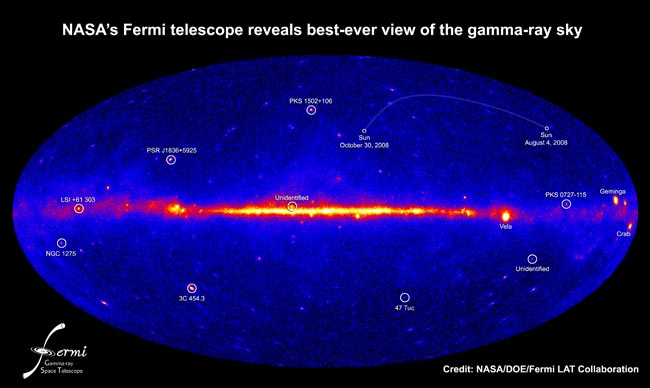Best View Ever of Universe's Most Extreme Energy

Astronomersnow have their best-ever view of the most extreme energy in the cosmos with anew map combining three month's worth of data, a team of scientists said today.
The map isbased on data collected by NASA's Fermi Gamma-ray Space Telescope, which hasscopes and cameras that peer out into the universe ? from within our solarsystem to galaxies billionsof light-years away ? in search of the sources of the highest energyradiation, called gamma rays.
Gamma rayssit on the far left of the electromagnetic, or light, spectrum, with shorterwavelengths and higher energy than ultraviolet light and even X-rays.
The all-skyimage produced by the Fermi team shows us how the cosmos would look if our eyescould detect radiation 150 million times more energetic than visible light. Theview merges observations from Fermi's LargeArea Telescope (LAT) spanning 87 days, from August 4, 2008, to October 30,2008.
"Fermihas given us a deeper and better-resolved view of the gamma-ray sky than anyprevious space mission," said Peter Michelson, the lead scientist for theLAT at Stanford University. "We're watching flares from supermassive blackholes in distant galaxies and seeing pulsars, high-mass binary systems, andeven a globular cluster in our own."
The mapincludes one object familiar to everyone: the sun. "Because the sunappears to move against the background sky, it produces a faint arc across theupper right of the map," Michelson explained.
During thenext few years, as solar activity increases, scientists expect the sun toproduce growing numbers of high-energy flares. "No other instrument willbe able to observe solar flares in the LAT's energy range," Michelsonsaid.
Get the Space.com Newsletter
Breaking space news, the latest updates on rocket launches, skywatching events and more!
From themap, the Fermi team created a "top 10" list of five sources withinthe Milky Way and five beyond our galaxy.
The topsources within our galaxy include the sun; a star system known as LSI +61 303,which pairs a massive normal star with a super-dense neutron star; PSRJ1836+5925, which is one of many new pulsars, a type of spinning neutron starthat emits gamma-ray beams; and the globular cluster 47Tucanae, a sphere of ancient stars 15,000 light-years away.
Topextragalactic sources include NGC1275, a galaxy that lies 225 million light years away and is known forintense radio emissions; the dramatically flaring active galaxies 3C 454.3 andPKS 1502+106, both more than 6 billion light years away; and PKS 0727-115,which is thought to be a type of active galaxy called a quasar.
The Fermitop 10 also includes two sources ? one within the Milky Way plane and onebeyond it ? that researchers have yet to identify.
A paperdescribing the 205 brightest sources the LAT sees has been submitted to TheAstrophysical Journal Supplement.
"Thisis the mission's first major science product, and it's a big step towardproducing our first source catalog later this year," said David Thompson,a Fermi deputy project scientist at NASA's Goddard Space Flight Center in Greenbelt, Md.
- Video ? The GLAST Cast Part 1, Part 2
- New Gamma-Ray Energy Source Spotted By Astronomers
- Vote: The Strangest Things in Space
Join our Space Forums to keep talking space on the latest missions, night sky and more! And if you have a news tip, correction or comment, let us know at: community@space.com.

Space.com is the premier source of space exploration, innovation and astronomy news, chronicling (and celebrating) humanity's ongoing expansion across the final frontier. Originally founded in 1999, Space.com is, and always has been, the passion of writers and editors who are space fans and also trained journalists. Our current news team consists of Editor-in-Chief Tariq Malik; Editor Hanneke Weitering, Senior Space Writer Mike Wall; Senior Writer Meghan Bartels; Senior Writer Chelsea Gohd, Senior Writer Tereza Pultarova and Staff Writer Alexander Cox, focusing on e-commerce. Senior Producer Steve Spaleta oversees our space videos, with Diana Whitcroft as our Social Media Editor.









